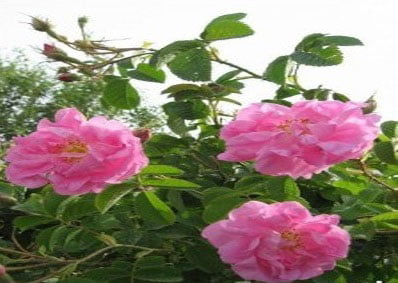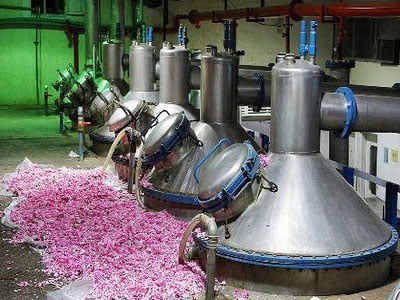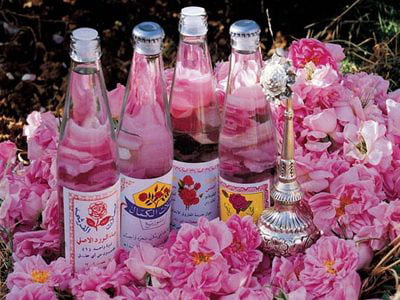Rose Garden

Rose Garden: distillation of flowers and herbs has a deep history in Iran. Many believe traditionally-distilled rosewater is of higher quality than that produced in factories probably due to the shorter time interval between the harvest and distillation practices.
People come to enjoy the sprite of full-bloom flower farms, to socialize with the locals, to visit abundant historical sites and see how rosewater is traditionally made from harvesting stage to steaming damask rose petals either at homes or gardens.
Rosewater is produced from a very sweet smelling kind of flowers, best known as Mohammadi roses in the country.
History of Rosewater in Iran
The first rose water production plant in Iran was established in Ghamsar in 1974-75 after studies were conducted by Bulgarian experts. It was built on the outskirts of Ghamsar (at the 15th kilometer of Ghamsar – Kashan road). The second rose water production plant was established at the entrance of Ghamsar city and is called Golriz. The cooperative company of rose water producers of Ghamsar has established a plant at the industrial park of Ghamsar in order to solve the problem of pasteurizing traditional rose water, which was the main hurdle on the way of production and sales of rose water.
Due to containing tannin, Gallic acid, essence, fatty acids, pigments and ascorbic acid (vitamin C), petals of Mohammadi flower are used not only for the production of rose water and essence but for production of rose petal jam.
Production of rosewater in Iran dates back to over 2,500 years. At present, Mohammadi Rose is produced in Bulgaria, Turkey, Iran, India, Ukraine, the US, Canada, France, Britain, and Japan. The first four countries are pioneers in the production of this flower.
Although the production of plant essences has a long history in Iran, traditional rose water production machines were used to produce rose water for commercial purposes. Before that, rose water was produced through small distillation equipment for local uses. Anyway, production of rose water has been in vogue since ancient time and has sometimes led to the prosperity of copper, glass making and packaging industries. Most of the local product is exported to other parts of the country and, therefore, despite most handicrafts, it has held its ground in contemporary times and has constantly improved in terms of quality and quantity.
How is the process of making rose water?

They pick flowers at 4 or 5 Am in the morning from gardens and they have to do it before sunrise because of sun decrease flowers’ smell then they clean and boil them and transfer steam in another container which is in water to cold steam and converts it to liquid.
Equipment used for extraction of rose water is nearly traditional and has hardly changed over the years. They include:
- A copper pot with a capacity of 120-150 liters;
- A big clay pot, which has not been replaced by the copper pot and is used to cover the pot. A major advantage of clay pot was that it did not burn the fragrance of the flower;
- A copper pitcher with handle and a capacity of about 30-40 liters which is put in cold water, so that flower streams are turned into liquid;
- Four wooden canes which are attached to each other to connect the pot to the pitcher; today, they use aluminum pipes instead of those canes;
- A water pool where liquefaction is done; and
- Heating equipment under the copper pot which is usually fed by oil or diesel fuel. In the past, they used wood and bushes to warm it up.
First, the copper pot is put on an oven made from bricks and cement or stones and mud. The heating agent is put below it. Then up to 30 kg of rose petals are poured into the pot and 80 liters of water is added. The pot is then covered and a heavyweight is put over it to control steam pressure. Probable holes and cracks are covered with a mortar made of the remnants of boil flowers and bread dough to prevent loss of steam.
Instead of weight and dough, they use elastic washers, screws, and levers. The copper pitcher is put into the water and is kept in place by a ladder, or more recently, by cast iron pipes, so that, it will not rise to the surface of the water. Then canes or aluminum pipes are inserted into the pot, on the one side, and into the pitcher, on the other side and they wrap it in a piece of fabric with a cotton ball, so that, water would not penetrate into the pitcher.
Now, everything is ready. They kindle the oven to boil the pot. At that time, rose water and water steam progress in the pipe as far as the angle. From there, rose water steam continues toward the pitcher and is liquidated due to the low temperature of the environment. It takes about 4 hours before a pitcher full of rose water (40 liters) is obtained. When they pour the rose water into the bottle, they wait for it to cool down.
Then they rub some oil on the bottle. The waste collected at the bottom of the pot, which is called “bongol”, is used to feed livestock and is also dried to be used as fuel in winter or as fertilizer for gardens.
During the whole process, the flame should be steady and mild. In better words, the longer the distillation period and the steadier the flame, the higher would be quality of the end product. The water poured into the pot should be measured accurately to be proportionate to the weight of flower petals.
The oldest city of rose in Iran
Experts maintain that Ghamsar has been a place for producing flower and rose water for a long time ago. Some believe that under Malekshah the Seljuk when Miyandeh Mosque of Ghamsar was built, representative of East Roman officials picked some roses from the slopes of Kouh Asbi mountain near Ghamsar and took them to Damascus (which was called Damask in those times) to be grown. This is why Iranian red flower is sometimes called Damask rose in English.
The city has been and still is the main production center for the highest quality rose water as a result of its natural and climatic conditions. According to a study carried out by professors of Tehran University, the essence of Mohammadi flower of Ghamsar and the subsequent rose water has a concentration of 35 mg per 100 ml or 350 ppm, which makes it the finest and highest quality rose water in Iran and even The garden city of Ghamsar is a patch of Paradise which becomes colorful as the spring begins. Its beauty is doubled when rose water ceremony commences and its hospitable people play host to millions of people who love nature and rose water of Ghamsar.
Mohammadi Rose (Rosa damascene or Damask rose) is among the most important Rose in the world and among the most famous plants.
Because of its extraordinary fragrance and diversity, this flower is planted in many parts of the world. The flower has applications in food, medicine and perfume industries. in the world.
History of Ghamsar
The ancient city of Ghamsar is like a shining star on the central Iranian desert.
Surrounding mountains encircle it like a ring and protect its rose gardens against the heat of the desert. The environment of this garden city, the shade of trees and sound of flowing water in addition to the music of birds and nightingales and fragrance of roses, has created an incredible milieu on the side of the desert.
Ghamsar is the breeding ground for the finest and the most exquisite Mohammadi flowers and has the best traditions and methods for the production of rose water. It is also the first place where industrial production of rose water has begun and there are many workshops in the city which produce rose water.
Another outcome of that situation was spread of the industry to neighboring villages of Ghamsar and even to other provinces during past decades. The emphasis put on Ghamsar is due to the high quality of its rose water which results from natural conditions of the city.
Mohammadi or red rose flower
The red rose, or Mohammadi rose, is further divided into seven groups: French red flower, wild rose, tea flower, miniature red flower, Bengalese red flower, and Iranian red flower.
Out of all rose species, the Iranian red flower or Mohammadi flower is unique and most botanists have opined that it has been first planted in Iran and then taken to other countries.
In Iran, Mohammadi Rose grows in the provinces of Fars, Kerman, Isfahan as well as East and West Azerbaijan.
The season for picking rose
The extracting of rosewater is from early May to mid-June.
In early May, the scent of rose spreads over different areas of Kashan, such as Qamsar Joshqan Qali, Barzak, and Niasar.
The ceremony for making rosewater in Kashan attracts many tourists. Every day, some 80,000 people tour various cities of Kashan for this traditional ceremony.
The arrival of tourists in the districts of Kashan has a positive impact on the region’s economy.
Rose water is made from a very sweet smelling kind of rose and is used in various traditional dishes and sweets. It is also used as a perfume among Muslims.
Although some modern mechanized factories are constructed, still a large part of this, let say industry, is done traditionally. And this traditional rose water production which is established at homes or gardens attracts tourists to Kashan. Historical monuments and architecture of Kashan add to the popularity of this festival too.
Rose water is widely used not only in medicine but also in cosmetology. Since ancient times, Persian beauties used rose oil and essence for softening and moisturizing dry skin. Rosewater is capable of giving the skin freshness and silky smoothness
Advantaged of rosewater

In Iran, rosewater is considered to be a miracle of nature. Rosewater has several advantages for the treatment and prevention of many diseases. It is believed that Prophet Muhammad was very fond of using rosewater. For this reason, the rose is also known as the “flower of Muhammad.” In the Iranian traditional medicine since ancient times people have known about the healing properties of rosewater and oil. Rosewater is an excellent anti-stress drug; it can strengthen the nervous system and help in the fight against insomnia. Rose has anti-inflammatory properties. It is effective in the treatment of gastrointestinal tract diseases, as well as bleeding and inflammation of the oral cavity.
On the other hand, we should consider that all benefits and advantages of rose water are not limited to just skin and hair care.it has a number of benefits for health which reduce stress and depression as well.
Export of rosewater
Iran is the top exporter of rose water in the world, said the head of Rose Water and Herbal Essences Union in Kashan, central Iran. Iran exports rose water to 30 countries, mainly to Saudi Arabia, the UAE, and Bahrain.
The UAE imports rose water in bulk, then repackages and exports the product to ensure a more efficient and lucrative trade.
Despite efforts to introduce the product to the world, rose water is not in high demand since many nations are unaware of its use, unlike rose essence which is well-known and widely consumed in perfume industries of Bulgaria and Turkey.
Iran began importing rose water from Iran two years ago, along with Korea that uses the comforting and refreshing effect of the product in saunas, and Germany which has recently imported it to meet food industries’ demand.
Iran produced 30,000 tons of rose water in Kashan in the year and the figure is expected to reach 33,000 tons. Currently, 75 percent of rose water is produced in 730 traditional workshops and 68 factories of Kashan, and the neighboring cities of Qamsar, Neyasar, and Bazrak, he added.
Primarily used either in confectionary and ice-cream industries or as natural medicine, rose water is also common during funerals and religious ceremonies.
It was Sassanid shahanshahs’ perfume which after Islam the name of flower changed to Gole Mohamadi (flower of Mohammad) and nowadays it becomes as the Islamic perfume and a large amount of this rosewater is sent to Mecca.
Related articles:
Comments